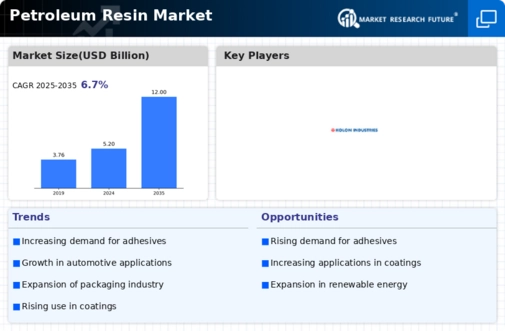Market Growth Projections
The Global Petroleum Resin Market Industry is poised for substantial growth, with projections indicating a market value of 5.2 USD Billion in 2024 and an anticipated rise to 12.0 USD Billion by 2035. This growth trajectory reflects a compound annual growth rate (CAGR) of 7.93% from 2025 to 2035, suggesting a robust expansion driven by diverse applications across various sectors. The increasing demand for high-performance materials in adhesives, coatings, and printing inks is likely to propel this growth. As industries continue to innovate and seek advanced solutions, the Global Petroleum Resin Market Industry appears well-positioned to capitalize on emerging opportunities.
Expansion in the Coatings Sector
The coatings sector plays a pivotal role in the Global Petroleum Resin Market Industry, as petroleum resins are integral to formulating high-quality paints and coatings. The increasing demand for durable and weather-resistant coatings across various industries, including automotive, marine, and industrial applications, propels market growth. The shift towards eco-friendly and sustainable coatings further enhances the appeal of petroleum resins, as they can improve the performance of low-VOC formulations. This sector's expansion is expected to contribute substantially to the market's growth trajectory, with projections indicating a rise to 12.0 USD Billion by 2035, underscoring the importance of petroleum resins in modern coatings.
Rising Applications in Printing Inks
The Global Petroleum Resin Market Industry is witnessing a notable increase in the use of petroleum resins in printing inks. These resins enhance the adhesion, gloss, and drying properties of inks, making them indispensable in the printing industry. As digital printing technologies advance and demand for high-quality printed materials rises, the need for effective resin formulations becomes apparent. The market's growth in this segment is indicative of the broader trend towards innovation in printing technologies. This increasing application of petroleum resins in printing inks not only supports the market's expansion but also highlights the versatility of these materials across various industries.
Growing Demand from Adhesives and Sealants
The Global Petroleum Resin Market Industry experiences a robust demand surge from the adhesives and sealants sector. This growth is primarily driven by the increasing utilization of petroleum resins in formulating high-performance adhesives that are essential in various applications, including construction, automotive, and packaging. As industries seek to enhance product performance and durability, the incorporation of petroleum resins becomes vital. The market is projected to reach 5.2 USD Billion in 2024, reflecting the escalating need for advanced adhesive solutions. This trend indicates a significant opportunity for manufacturers to innovate and expand their product offerings in the Global Petroleum Resin Market Industry.
Increasing Demand for Sustainable Products
The Global Petroleum Resin Market Industry is increasingly shaped by the demand for sustainable products. As consumers and industries prioritize eco-friendly materials, petroleum resins are being reformulated to meet these expectations. Manufacturers are exploring bio-based alternatives and recycling processes to reduce environmental impact while maintaining performance standards. This shift towards sustainability not only aligns with global environmental initiatives but also opens new market opportunities. The growing emphasis on sustainable practices is likely to influence product development and marketing strategies within the Global Petroleum Resin Market Industry, fostering innovation and potentially leading to increased market share.
Technological Advancements in Resin Production
Technological advancements in the production of petroleum resins are significantly influencing the Global Petroleum Resin Market Industry. Innovations in manufacturing processes, such as the development of more efficient polymerization techniques, lead to enhanced resin quality and performance. These advancements enable manufacturers to produce resins that meet the evolving demands of various applications, from adhesives to coatings. Furthermore, the integration of sustainable practices in resin production aligns with global environmental goals, potentially attracting a broader customer base. As these technologies continue to evolve, they are likely to drive market growth and enhance the competitive landscape within the Global Petroleum Resin Market Industry.











